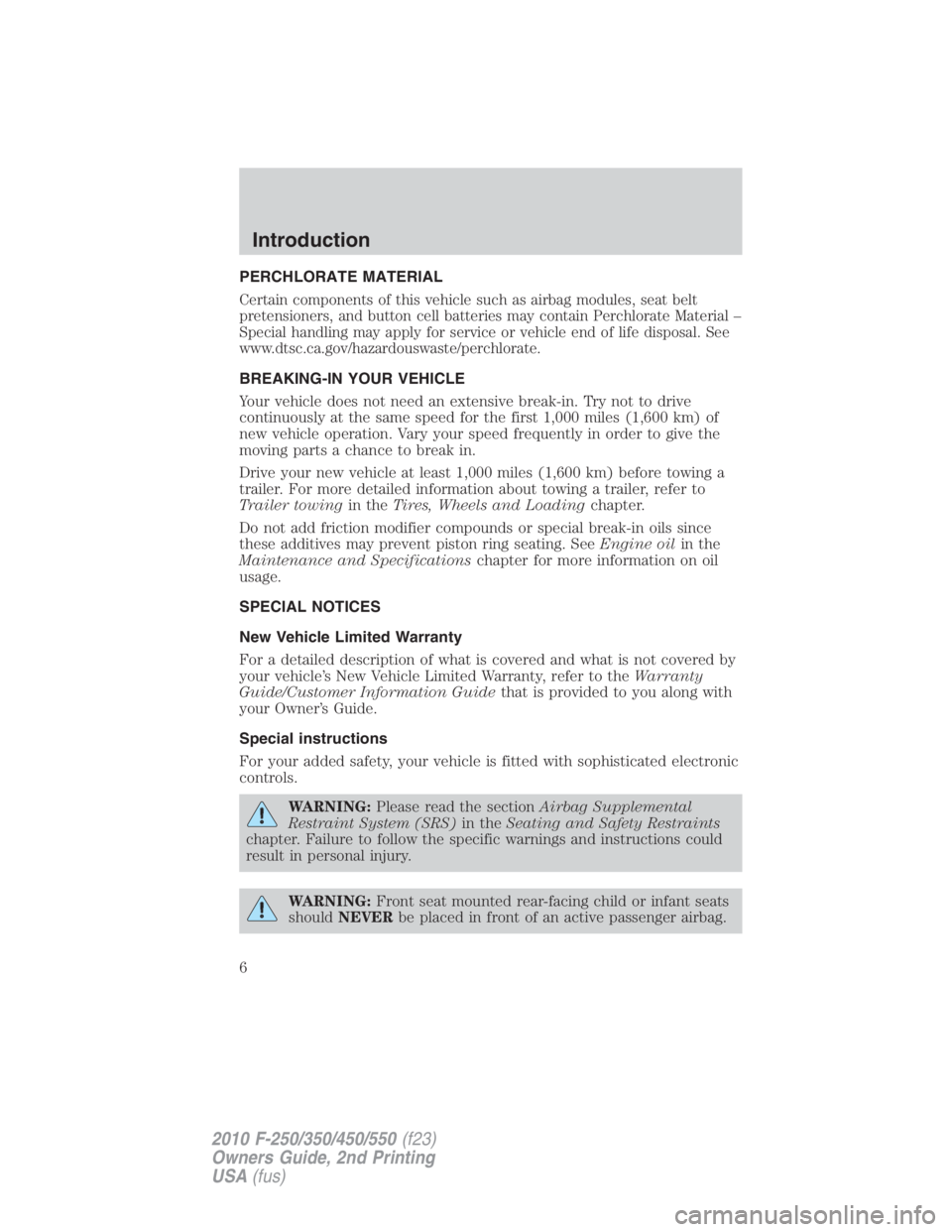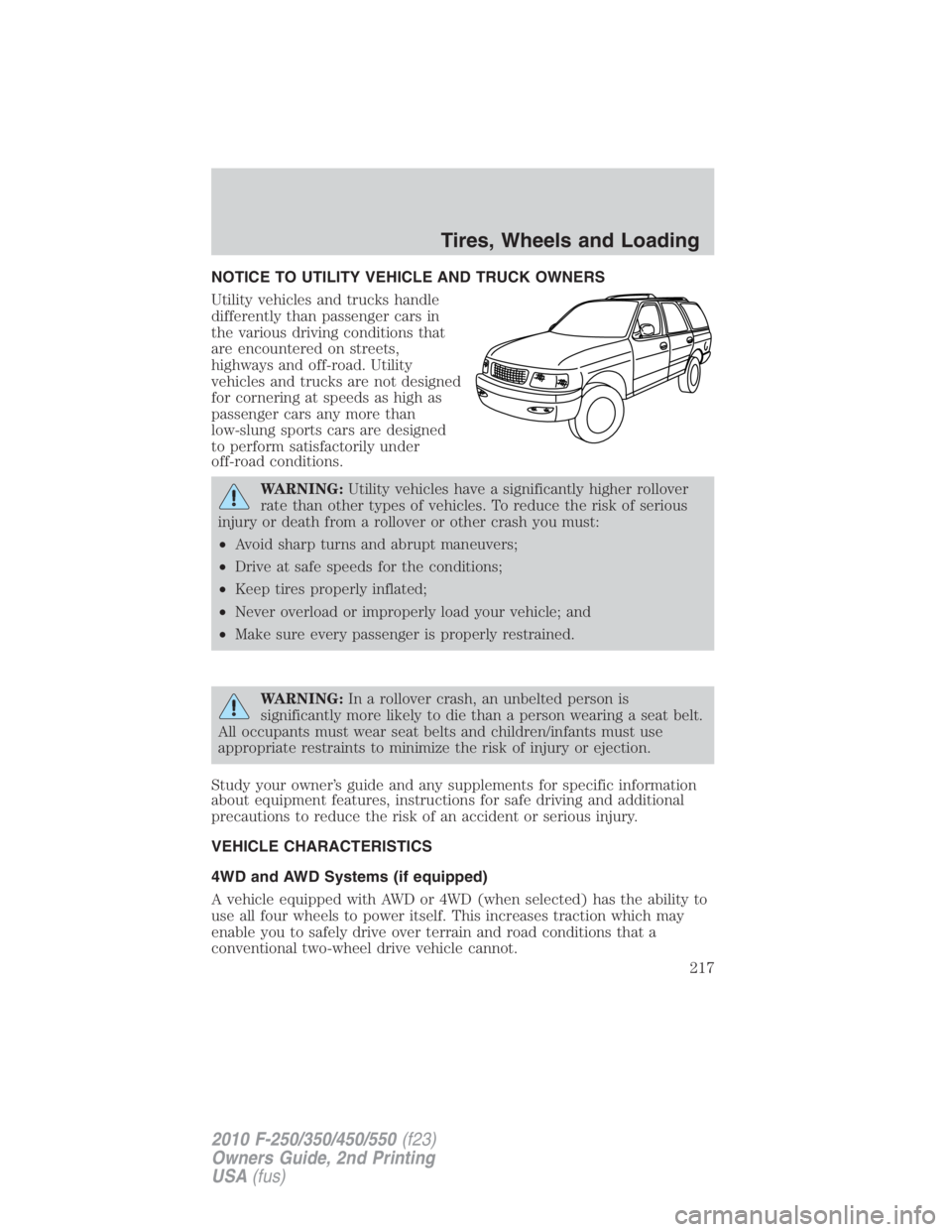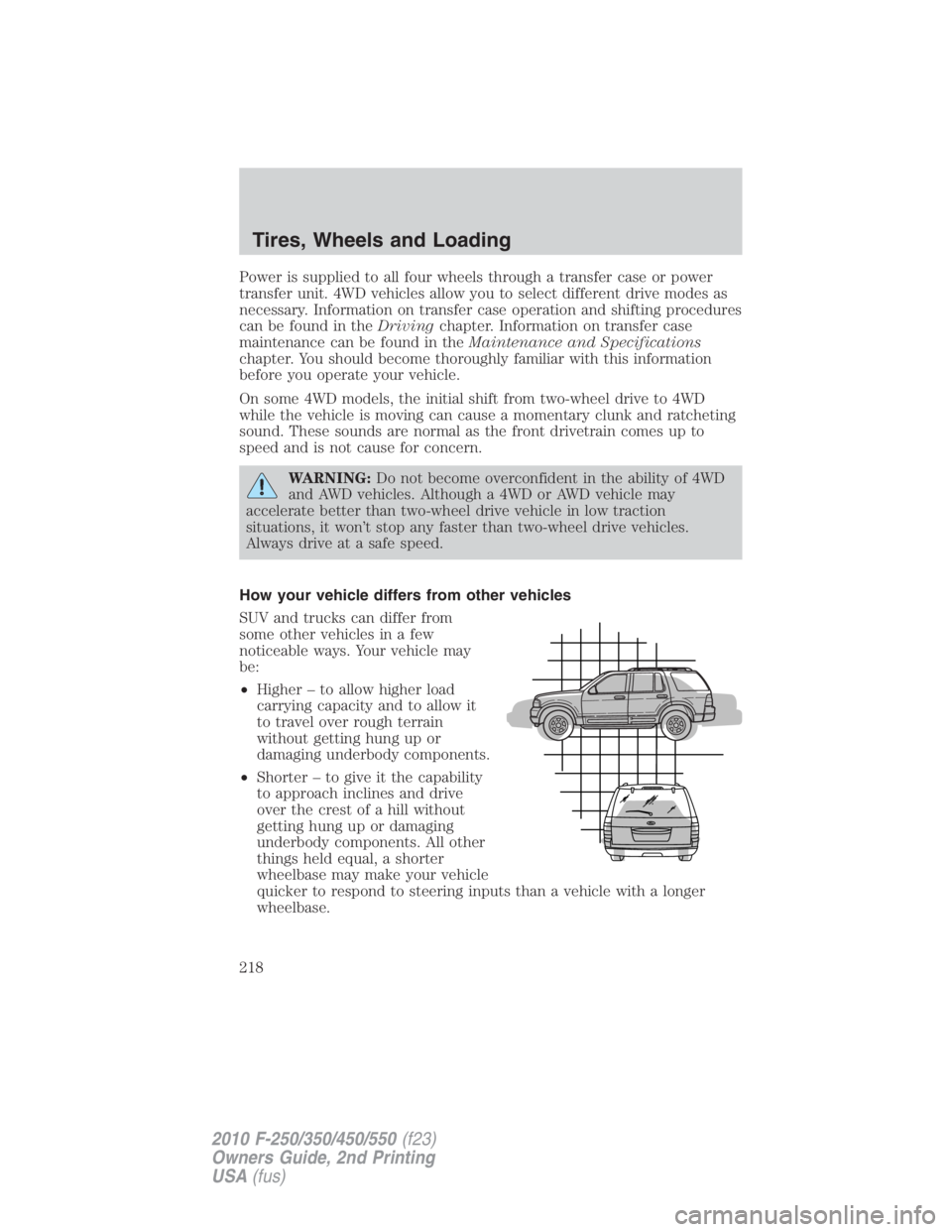2010 FORD F550 tires
[x] Cancel search: tiresPage 2 of 408

Locks and Security 148Keys 148
Locks 148
Anti-theft system 159
Seating and Safety Restraints 164Seating 164
Safety restraints 173
Airbags 185
Child restraints 195
Tires, Wheels and Loading 217Tire information 219
Tire inflation 221
Tire Pressure Monitoring System (TPMS) 237
Vehicle loading 244
Trailer towing 251
Trailer brake controller-integrated 256
Recreational towing 262
Driving 264Starting 264
Brakes 269
Traction Control™ 271
Transmission operation 275
Reverse sensing system 280
Rear-view camera system 282
Roadside Emergencies 303Getting roadside assistance 303
Hazard flasher control 304
Fuel pump shut-off switch 305
Fuses and relays 306
Changing tires 315
Wheel lug nut torque 330
Jump starting 331
Wrecker towing 336Table of Contents
2
2010 F-250/350/450/550 (f23)
Owners Guide, 2nd Printing
USA (fus)
Page 6 of 408

PERCHLORATE MATERIAL
Certain components of this vehicle such as airbag modules, seat belt
pretensioners, and button cell batteries may contain Perchlorate Material –
Special handling may apply for service or vehicle end of life disposal. See
www.dtsc.ca.gov/hazardouswaste/perchlorate.
BREAKING-IN YOUR VEHICLE
Your vehicle does not need an extensive break-in. Try not to drive
continuously at the same speed for the first 1,000 miles (1,600 km) of
new vehicle operation. Vary your speed frequently in order to give the
moving parts a chance to break in.
Drive your new vehicle at least 1,000 miles (1,600 km) before towing a
trailer. For more detailed information about towing a trailer, refer to
Trailer towing in the Tires, Wheels and Loading chapter.
Do not add friction modifier compounds or special break-in oils since
these additives may prevent piston ring seating. See Engine oil in the
Maintenance and Specifications chapter for more information on oil
usage.
SPECIAL NOTICES
New Vehicle Limited Warranty
For a detailed description of what is covered and what is not covered by
your vehicle’s New Vehicle Limited Warranty, refer to the Warranty
Guide/Customer Information Guide that is provided to you along with
your Owner’s Guide.
Special instructions
For your added safety, your vehicle is fitted with sophisticated electronic
controls.
WARNING: Please read the section Airbag Supplemental
Restraint System (SRS) in the Seating and Safety Restraints
chapter. Failure to follow the specific warnings and instructions could
result in personal injury.
WARNING: Front seat mounted rear-facing child or infant seats
should NEVER be placed in front of an active passenger airbag.Introduction
6
2010 F-250/350/450/550 (f23)
Owners Guide, 2nd Printing
USA (fus)
Page 17 of 408

Low tire pressure warning (if
equipped): Illuminates when your
tire pressure is low. If the light
remains on at start up or while
driving, the tire pressure should be
checked. Refer to Inflating your tires in the Tires, Wheels and
Loading chapter. When the ignition is first turned to on, the light will
illuminate for three seconds to ensure the bulb is working. If the light
does not turn on, have the system inspected by your authorized dealer.
For more information on this system, refer to Understanding your tire
pressure monitoring system (TPMS) in the Tires, Wheels and
Loading chapter.
Charging system: Illuminates when
the battery is not charging properly.
If it stays on while the engine is
running, there may be a malfunction
with the charging system. Contact your authorized dealer as soon as
possible. This indicates a problem with the electrical system or a related
component.
Powertrain malfunction/Reduced
power/Electronic throttle
control (RTT): Displays when the
engine has defaulted to a
“limp-home” operation or when a transmission problem has been
detected and shifting may be restricted. If the light remains on, have the
system serviced immediately by your authorized dealer.
Traction control (RTT) (if
equipped): Displays when the
traction control system is active. If
the light remains on, have the
system serviced immediately by
your authorized dealer. Refer to Traction control in the Driving chapter
for more information
Check fuel cap (RTT): Displays
when the fuel cap may not be
properly installed. Continued driving
with this light on may cause the
Service engine soon warning light to
come on. Refer to Fuel filler cap in
the Maintenance and Specifications chapter.Instrument Cluster
17
2010 F-250/350/450/550 (f23)
Owners Guide, 2nd Printing
USA (fus)
Page 29 of 408

WIRING FAULT ON TRAILER (if equipped) — Displayed if there
are certain faults in the vehicle wiring and trailer wiring/brake system.
Refer to Trailer towing in the Tires, Wheels and Loading chapter for
more information.
TRAILER BRAKE MODULE FAULT (if equipped) — Displayed and
accompanied by a single chime, in response to faults sensed by the TBC.
Refer to Trailer towing in the Tires, Wheels and Loading chapter for
more information.
TRAILER DISCONNECTED (if equipped) — Displayed when a
trailer connection becomes disconnected, either intentionally or
unintentionally, and has been sensed during a given ignition cycle. Refer
to Trailer towing in the Tires, Wheels and Loading chapter for more
information.
BRAKE FLUID LEVEL LOW — Indicates the brake fluid level is low
and the brake system should be inspected immediately. Refer to Brake
fluid in the Maintenance and Specifications chapter.
LOW TIRE PRESSURE (if equipped) — Displayed when one or more
tires on your vehicle have low tire pressure. Refer to Inflating your
tires in the Tires, Wheels and Loading chapter.
TIRE PRESSURE MONITOR FAULT (if equipped) — Displayed
when the Tire Pressure Monitoring System is malfunctioning. If the
warning stays on or continues to come on, contact your authorized
dealer as soon as possible.
TIRE PRESSURE SENSOR FAULT (if equipped) — Displayed when
a tire pressure sensor is malfunctioning, or your spare tire is in use. For
more information on how the system operates under these conditions,
refer to Understanding Your Tire Pressure Monitoring System
(TPMS) in the Tires, Wheels and Loading chapter. If the warning stays
on or continues to come on, contact your authorized dealer as soon as
possible.
ENGINE WARMING PLEASE WAIT XX (Diesel engine only) —
Displayed in extremely cold weather, typically below –15°F (–26°C), if
the engine block heater is not utilized. The engine will not respond to
accelerator pedal movement for 30 seconds; this is done so the engine oil
can be properly circulated to avoid engine damage from lack of
lubrication. A timer will begin a countdown from 30 seconds. Once the
counter has reached 0 (zero) seconds, OK TO DRIVE will be displayed
and the engine will respond to accelerator pedal movement. Refer to
your Power Stroke 6.0 and 6.4 Liter Direct Injection Turbo Diesel
Owner’s Guide Supplement for more information.Instrument Cluster
29
2010 F-250/350/450/550 (f23)
Owners Guide, 2nd Printing
USA (fus)
Page 38 of 408

PARK BRAKE ENGAGED — Displayed when the parking brake is
applied (or not fully released).
CHECK BRAKE SYSTEM — Displayed when a fault has been detected
by the ABS module.
DRIVER DOOR AJAR — Displayed when the driver’s door is not
completely closed.
PASSENGER DOOR AJAR — Displayed when the passenger’s door is
not completely closed.
REAR LEFT DOOR AJAR — Displayed when the rear left door is not
completely closed.
REAR RIGHT DOOR AJAR — Displayed when the rear right door is
not completely closed.
XXX MILES TO E FUEL LEVEL LOW — Displayed as an early
reminder of a low fuel condition.
CHECK PARK AID (if equipped) — Displayed when the transmission
is in R (Reverse) and the reverse sensing system (park aid) is disabled.
TO STOP ALARM START VEHICLE (if equipped) — Displayed
when the perimeter alarm system is armed and the vehicle is entered
using the key on the driver’s side door. In order to prevent the perimeter
alarm system from triggering, the ignition must be turned to start or on
before the 12–second chime expires. See Perimeter alarm system in the
Locks and Security chapter.
WIRING FAULT ON TRAILER (if equipped) — Displayed and
accompanied by a single chime if there are certain faults in the vehicle
wiring and trailer wiring/brake system. Refer to Trailer towing in the
Tires, Wheels and Loading chapter for more information.
TRAILER BRAKE MODULE FAULT (if equipped) — Displayed and
accompanied by a single chime in response to faults sensed by the TBC.
Refer to Trailer towing in the Tires, Wheels and Loading chapter for
more information.
TRAILER CONNECTED (if equipped) — Displayed when a correct
trailer connection (a trailer with electric trailer brakes) is sensed during
a given ignition cycle. Refer to Trailer towing in the Tires, Wheels and
Loading chapter for more information.
TRAILER DISCONNECTED (if equipped) — Displayed and
accompanied by a single chime when a trailer connection becomes
disconnected, either intentionally or unintentionally, and has been sensed
during a given ignition cycle. Refer to Trailer towing in the Tires,
Wheels and Loading chapter for more information.Instrument Cluster
38
2010 F-250/350/450/550 (f23)
Owners Guide, 2nd Printing
USA (fus)
Page 39 of 408

BRAKE FLUID LEVEL LOW — Indicates the brake fluid level is low
and the brake system should be inspected immediately. Refer to Brake
fluid in the Maintenance and Specifications chapter.
LOW TIRE PRESSURE (if equipped) — Displayed when one or more
tires on your vehicle have low tire pressure. Refer to Inflating your
tires in the Tires, Wheels and Loading chapter.
TIRE PRESSURE MONITOR FAULT (if equipped) — Displayed
when the Tire Pressure Monitoring System is malfunctioning. If the
warning stays on or continues to come on, contact your authorized
dealer as soon as possible.
TIRE PRESSURE SENSOR FAULT (if equipped) — Displayed when
a tire pressure sensor is malfunctioning, or your spare tire is in use. For
more information on how the system operates under these conditions,
refer to Understanding Your Tire Pressure Monitoring System
(TPMS) in the Tires, Wheels and Loading chapter. If the warning stays
on or continues to come on, contact your authorized dealer as soon as
possible.
ENGINE WARMING PLEASE WAIT XX (Diesel engine only) —
Displayed in extremely cold weather, typically below –15°F (–26°C), if
the engine block heater is not utilized. The engine will not respond to
accelerator pedal movement for 30 seconds; this is done so the engine oil
can be properly circulated to avoid engine damage from lack of
lubrication. A timer will begin a countdown from 30 seconds. Once the
counter has reached 0 (zero) seconds, OK TO DRIVE will be displayed
and the engine will respond to accelerator pedal movement. Refer to
your Power Stroke 6.0 and 6.4 Liter Direct Injection Turbo Diesel
Owner’s Guide Supplement for more information.
OK TO DRIVE (Diesel engine only) — Displayed when the time
counter has reached 0 (zero) and the engine is sufficiently warm enough
to drive in extremely cold weather (refer to the engine warming please
wait message description mentioned previously). Refer to your Power
Stroke 6.0 and 6.4 Liter Direct Injection Turbo Diesel Owner’s Guide
Supplement for more information.
DRAIN WATER SEPARATOR (Diesel engine only) — Displayed
when the water separator has reached a predetermined capacity and
needs to be drained. Refer to your Power Stroke 6.0 and 6.4 Liter
Direct Injection Turbo Diesel Owner’s Guide Supplement for more
information. Instrument Cluster
39
2010 F-250/350/450/550 (f23)
Owners Guide, 2nd Printing
USA (fus)
Page 217 of 408

NOTICE TO UTILITY VEHICLE AND TRUCK OWNERS
Utility vehicles and trucks handle
differently than passenger cars in
the various driving conditions that
are encountered on streets,
highways and off-road. Utility
vehicles and trucks are not designed
for cornering at speeds as high as
passenger cars any more than
low-slung sports cars are designed
to perform satisfactorily under
off-road conditions.
WARNING: Utility vehicles have a significantly higher rollover
rate than other types of vehicles. To reduce the risk of serious
injury or death from a rollover or other crash you must:
• Avoid sharp turns and abrupt maneuvers;
• Drive at safe speeds for the conditions;
• Keep tires properly inflated;
• Never overload or improperly load your vehicle; and
• Make sure every passenger is properly restrained.
WARNING: In a rollover crash, an unbelted person is
significantly more likely to die than a person wearing a seat belt.
All occupants must wear seat belts and children/infants must use
appropriate restraints to minimize the risk of injury or ejection.
Study your owner’s guide and any supplements for specific information
about equipment features, instructions for safe driving and additional
precautions to reduce the risk of an accident or serious injury.
VEHICLE CHARACTERISTICS
4WD and AWD Systems (if equipped)
A vehicle equipped with AWD or 4WD (when selected) has the ability to
use all four wheels to power itself. This increases traction which may
enable you to safely drive over terrain and road conditions that a
conventional two-wheel drive vehicle cannot. Tires, Wheels and Loading
217
2010 F-250/350/450/550 (f23)
Owners Guide, 2nd Printing
USA (fus)
Page 218 of 408

Power is supplied to all four wheels through a transfer case or power
transfer unit. 4WD vehicles allow you to select different drive modes as
necessary. Information on transfer case operation and shifting procedures
can be found in the Driving chapter. Information on transfer case
maintenance can be found in the Maintenance and Specifications
chapter. You should become thoroughly familiar with this information
before you operate your vehicle.
On some 4WD models, the initial shift from two-wheel drive to 4WD
while the vehicle is moving can cause a momentary clunk and ratcheting
sound. These sounds are normal as the front drivetrain comes up to
speed and is not cause for concern.
WARNING: Do not become overconfident in the ability of 4WD
and AWD vehicles. Although a 4WD or AWD vehicle may
accelerate better than two-wheel drive vehicle in low traction
situations, it won’t stop any faster than two-wheel drive vehicles.
Always drive at a safe speed.
How your vehicle differs from other vehicles
SUV and trucks can differ from
some other vehicles in a few
noticeable ways. Your vehicle may
be:
• Higher – to allow higher load
carrying capacity and to allow it
to travel over rough terrain
without getting hung up or
damaging underbody components.
• Shorter – to give it the capability
to approach inclines and drive
over the crest of a hill without
getting hung up or damaging
underbody components. All other
things held equal, a shorter
wheelbase may make your vehicle
quicker to respond to steering inputs than a vehicle with a longer
wheelbase.Tires, Wheels and Loading
218
2010 F-250/350/450/550 (f23)
Owners Guide, 2nd Printing
USA (fus)